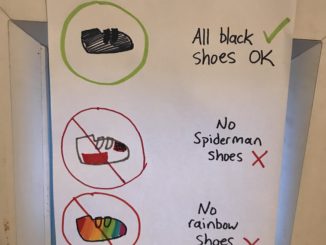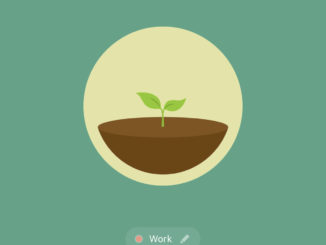Continuing my series about the apps I use in my everyday life:
FINCH
This is my current app obsession. Finch is a little virtual bird. You set goals in the app for taking care of yourself, and as you complete the goals, your little bird goes on adventures and unlocks clothes, furniture for their house, different appearances, etc.
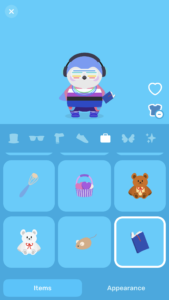
I was immediately impressed by how non-judgmental the app was. That feels like a weird sentence to write, but it was one of the first things I thought. It prompts you to set your first goal, and it allows you to write your own goal or use one of its suggested goals. The suggested goals were stated with so much compassion for what it’s like to be in a very difficult place that it felt very meaningful to me. It has goals that are of an objectively higher “difficulty” and lower “difficulty” without any value judgment placed on which kind of goals you’re setting for yourself, which I love, because it levels the playing field a little bit — it acknowledges, without ever overtly saying it or having to draw attention to itself about it, that “objective difficulty” in relationship to a goal you’re setting for yourself is nonsensical anyway. One person might want the external motivation to get out of bed and brush their teeth. Another person might use it to remind themselves to meal prep for the week or vacuum a room. Or the same person could use both. I have goals in my own Finch app for all of the above.
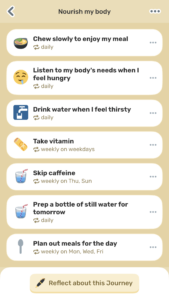
In addition to setting goals, it has a lot of mindfulness tools embedded in the app. You can set a focus timer, with or without background sound. You can set a soundscape and listen to white noise. You can do breathing exercises along with the app’s very simple, soothing visual for breathing in, holding, and breathing out. You can do simple yoga movements or stretches with little videos of someone modeling them. I use all of these tools infrequently, but I do use them. As you use them, you earn the in-game currency, so you can get more accessories for your little bird.
The tool I use the most often personally is the ability to journal. It gives you the option to journal about literally anything you do (without being overwhelming). Anytime you complete a goal, it’s very easy to click a button and journal a thought about how that goal went. I do this constantly. You can also access the journal anytime to answer prompt questions if you want, or to free-form journal to get your thoughts out. The app also automatically pulls key words from what you have journaled and gives you insights into your patterns. For example, I can look at the journal, tap on some time I’ve written my husband’s name or my kids’ names, and read all the times I’ve ever journaled about my husband or my kids.
The app also gives you a once-a-week summary where it does its best to take those key words and draw some gentle, nonjudgmental conclusions about how those things have been making you feel. It’ll tell me that I’ve been expressing more optimism in journal entries where I write about my husband, or that I’ve been expressing more anxiety in journal entries where I write about work — things like that. Because it’s a computer automatically collating this information, sometimes it leads to slightly “off” or humorous conclusions — one time it told me that I was expressing a lot of anxiety about sandwiches lately because twice in a row I’d written something about my lunch break! But for the most part, and especially as you get to know the app, it can be really helpful for understanding patterns in your own thinking.
There’s a free version and a paid version. I made myself use the free version for 50 days before letting myself upgrade to the paid one, because I wanted to prove to myself that I would stick with it for a little while. Honestly, the difference between the two is very minimal — you get access to all of the tools and every part of the app for free. I largely wanted to subscribe to the paid one to support the developers, and it also unlocks some extra items, some extra options for some of the tools, etc. For example, you get access to a wider variety of soundscapes, exercises, or breathing patterns.
I could ramble quite a lot more about how I love Finch and how I use it, but this is a good overview. I’ll give one more thing that I like about it: you can simply “check in” every couple of hours with a simple, 1-5 scale on how you’re feeling (expressed with sad face, neutral face, and happy face emojis). In your journal, it’ll show how your moods were over the course of the day. This was really helpful for me during some periods of feeling extremely down. I was feeling like I was sad all day, every day. Having tangible evidence to look at helped me realize that I wasn’t actually sad all day every day…I was sad for some amounts of time, and also happy for some amounts of time. I could see patterns, like the times of day when I tended to feel the most down.
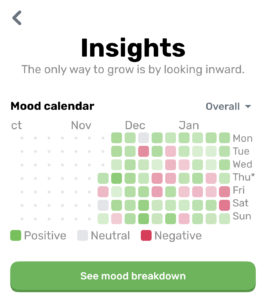
The app’s ability to help you see and mindfully react to your own patterns is probably the best part about it, and I’ll actually write in more depth about how I use some of these to help myself get more mentally well in my eating, self-care, and executive functioning eventually but this is a great start.

